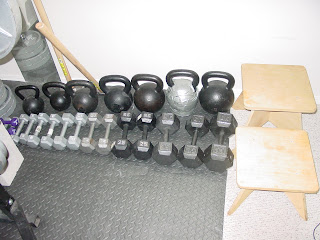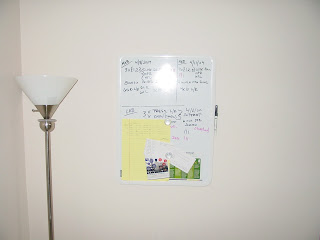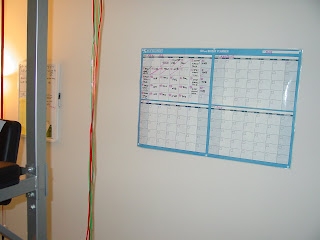I think it's time for some more specifics on building and outfitting a home gym.
Let's take a few different scenarios and see what we can come up with:
1. Unlimited space, unlimited budget. (Suburban livin')
2. Limited space, unlimited budget. (City livin')
3. Unlimited space, limited budget. (Country livin')
4. Limited space, limited budget. (Solitary confinement)
Suburban livin'The first, and easiest is unlimited space, unlimited budget. Just take exactly what you do at your commercial gym and take it into the home arena. Get the biggest, nicest power rack that you can find, a great olympic set with bumpers, and fill in with whichever other pieces of equipment strike your fancy--adjustable cable crossovers, a full rack of hex dumbbells, glute-ham raise, monolift, leg press, etc. Basically, you can replicate your gym right now, but eliminate the waiting, and increase the quality of some of the equipment (nicer bars that won't bend, nicer bumper plates, better power rack, etc.)
City livin'A little more interesting is a situation where you have very limited options in terms of space. In this situation, think about the most space efficient equipment that you can: a lifting platform and olympic set, a chinup bar and rings, and kettlebells can all be options if you don't have enough room for a fully fledged gym. I would probably go with some power blocks or some other selectorized or adjustable dumbbell equipment in this scenario, and a simple flat bench. You can store the dumbbells under the bench and push them out of the way when they're not in use. I would probably go running or do calesthenics for cardio.
Country Livin'If you're set up in a barn or an open field, but you have less than a hundred bucks, this would be your situation. I would prioritize your equipment needs and try to scavenge as much as possible. You can use sledgehammers and hit an old tire (free if you've got the sledge) or calesthencs or jump rope (five bucks) for cardio. For resistance training, I think I would look to do rafter pullups or look for a playground to do dips and chins. Again, try to get a basic olympic set and build a platform, or hang some playground rings for pull ups, muscle ups, and dips. You can push a wheelbarrow filled with scrap metal, build your own sandbags, build your own medicine balls, get a keg from a liquor store, or build your own isometrics devices for very cheap as well. Cinder blocks make for good ways to adjust the height of your exercises: you can do all kinds of varieties of push ups with your feet or hands elevated to change the emphasis.
Solitary ConfinementIf you're a teenager living at home, or you live in a dorm, or if you are actually in prison, this is the scenario you find yourself in. A lot of the same things apply to you too. Calesthenics are your friends: burpees and jumping jacks for cardio, pushups, squats, pistols, and pullups if you can find the space. You can vary the height of your pushups using your bed.
Even this very abbreviated type of program can get results, and you don't even need any equipment or much space to begin. So start here, if you have to, and build from there.
Of course, a lot of you are going to have some combination of these, a medium amount of space and a small budget, or a medium budget and medium space. Combine these suggestions appropriately.
So given the time and space, what are the biggest bangs for your buck?
1.
Homemade equipment: Ostensibly, this is the cheapest, and you can get a lot of benefit out of filling a bag or a keg with sand.
2.
Inexpensive equipment: jump ropes and ab wheels make this very short list.
3.
An Olympic set: Just with this, you can get a lot of the benefits of having a home gym. Deadlifts, rows, military presses, curls, Turkish-get-ups. (Add a lifting platform if you need to).
4.
A chinup bar: The lats are the biggest muscles in the upper body, and nothing builds the lats better than a chinup bar. Pullups, chinups, hanging leg raises.
5.
An adjustable bench: A lot more pressing options open up to you with this piece of equipment.
6.
Dumbbells: These can definitely be an option to complement or replace the Olympic set. I would suggest getting adjustable ones to get the most bang for your buck, both in terms of money and adjustability. You can get hex dumbbells, but then you end up spending the same money over and over again. (I.E. if you buy a 70 and 80 pound hex dumbbell, you have to pay for 150 pounds of weights. If you buy a dumbbell handle with 80 pounds, you have both a 70 and 80 pound dumbbell). These are also good if you don't have a training partner or a power rack to spot you.
7.
A power rack: If you're really serious about training, eventually, you're going to need a power rack. The issues are both space and money. A power rack can take up as much as 3x3x8 feet, and cost up to $5000. If you're serious about training by yourself, though, there is no replacement for a good power rack. This is where home gyms can become real replacements for commercial gyms.
8.
High/low pulley systems: This opens up woodchoppers, lat pulldowns, pullthroughs, low rows, and some other fun options.
9.
Adjustable/cable crossover pulley systems This is another fun addition, a little nicer than the last.
10.
Serious training stuff If you've gotten to this point, and you're still building up your gym, you probably know what's going to help you reach your goals at this point. If you're trying to lose fat, maybe some cardio equipment would help. If you're gaining muscle, then some machines would be nice. If you're a powerlifter, Dave Tate has
advice for you. Start with what I've suggested above and then start thinking in this direction as your budget, space, and ability level allows.
Also, check out
this thread to give you some ideas of how other people have solved the home-gym conundrum.
 Here's what I've been reading this week:
Here's what I've been reading this week:











